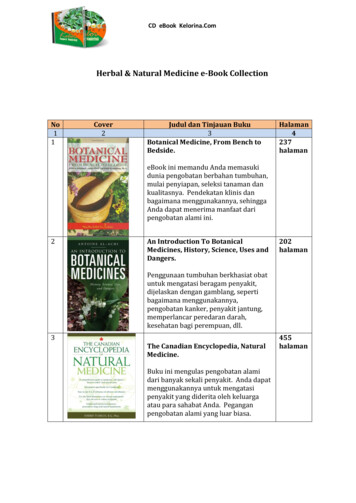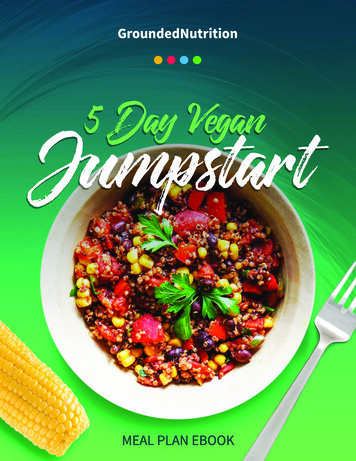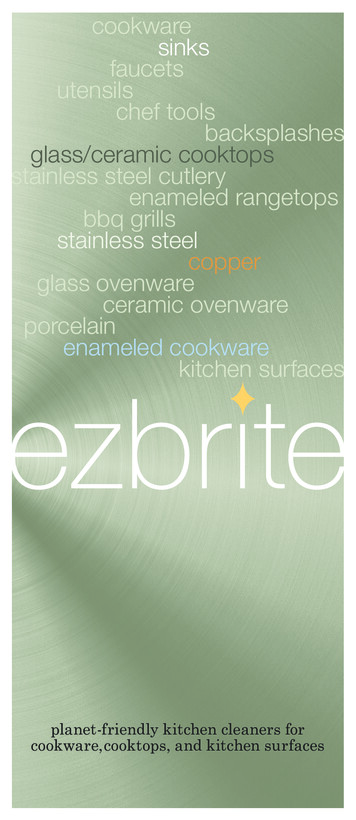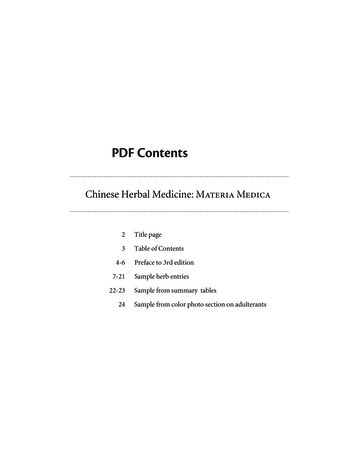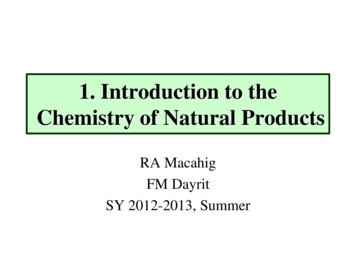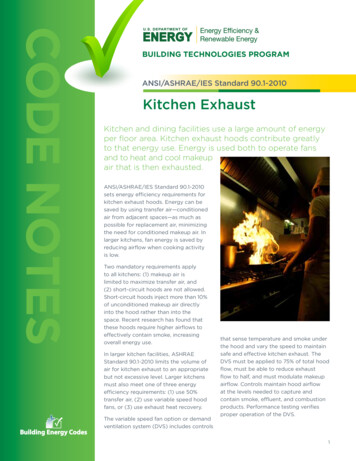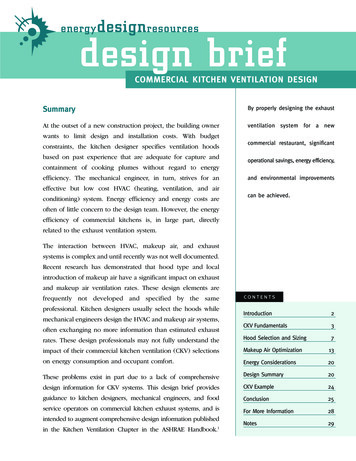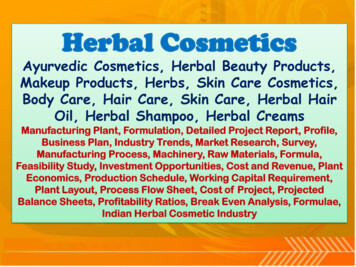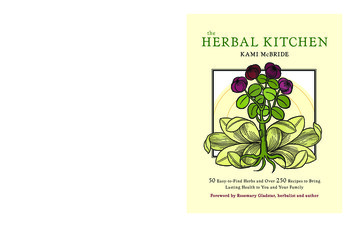
Transcription
“In The Herbal Kitchen sits the rich green heart of herbalism in all its abundance, simplicity, andpracticality. Medicines are made, recipes exchanged, and wise adages passed along to the reader.One can almost smell the flowers, taste the cup of tea in hand, so homespun and real are the teachings that Kami shares.” —Rosemary Gladstar, from the forewordWith over 250 recipes for herbal oils, vinegars, pestos, dressings, salts, cordials, syrups, smoothies,and more, The Herbal Kitchen will give you the confidence and the knowledge to boost immunity, healsickness, enhance energy, and ensure overall health and vitality for you and your family—all without fancy equipment or specialty products. Readers will learn how to prepare, store, and use herbs,many right off their common spice rack, and create their own long-term healthcare plan.“I learned a lot from The Herbal Kitchen, and I’m keeping it in my kitchen so I can refer to it often.I love this book!” —Christiane Northrup, MD, author of the New York Times bestsellers Women'sBodies, Women's Wisdom and The Wisdom of Menopause“Be prepared for a whole new way of thinking about herbs. Kami McBride resurrects traditional knowledge of herbs’ medicinal and culinary attributes for use in the modern kitchen.” —Ann Vileisis, authorof Kitchen Literacy: How We Lost Knowledge of Where Food Comes From and Why We Need To Get It Back“Everything you ever wanted to know about the healing power of herbs and spices are nicely tuckedwithin these pages. This is a must-have book for everyone’s kitchen!” —Rebecca Katz, MS, authorof The Cancer-Fighting Kitchen: Big Flavor Recipes for Cancer Treatment and Recovery.U.S. 18.95ISBN: 978-1-57324-421-35 1 8 9 59781573244213HERBAL KITCHENK AMI McBRIDEHERBAL KITCHEN“If you’ve ever cooked with herbs, made herbal tea, or eaten pesto with basil (or edible flowers as Kamisuggests), you will love this book. If not, you need this book.” —Pam Montgomery, herbalist, educator,and author of Plant Spirit Healing and Partner Earth: A Spiritual Ecologythethe“Do you enjoy eating garlic bread? Does oregano always find its way into your spaghetti sauce? Doyou garnish potato salad with paprika? Then you are participating in the ancient tradition of usingherbs to enhance the health benefits and digestibility of your food. Herbs in the kitchen not onlyaugment the flavor of what we eat, they support our overall health and wellness on a daily basis.Whether you are a seasoned cook or just cutting your teeth in the kitchen, these pages will assistyou in nurturing and healing yourself and your loved ones.” —from the introductionMcBRIDED I S C OV E R T H E N AT U R A L P H A R M A C Yxwxwxwx I N YO U R K I TC H E N C U P B O A R D wxwxwxww50 Easy-to-Find Herbs and Over 250 Recipes to BringLasting Health to You and Your FamilyForeword by Rosemary Gladstar, herbalist and author
theHERBALKITCHENK AMI McBRIDE50 Easy-to-Find Herbs and Over250 Recipes to BringLasting Health to You and Your Family
This book is dedicated to my mother.Her never-ending love and supportinspired me to follow my heart.
AcknowledgmentswxwxwxwxwxwxwxwxwxwxwxwxwxwxThank you to Red Wheel Weiser and Conari Press for helping me to make thisbook a reality. Thank you to all my teachers who have helped guide and inspiremy work and life. I am very grateful to everyone who has participated in myclasses over the years; being with all of you has shaped and given an immeasurable depth to my life. Thank you to everyone who has been a part of this wonderful journey learning about plants. I am forever grateful for the beauty andmystery of plants and how they continue to be such extraordinary teachers. Mywish is that these pages benefit and bring health to all.
ContentswxwxwxwxwxwxwxwxwxwxwxwxwxwxForeword . page 8Introduction . page 10chapter 1Kitchen Medicine and Culinary Culture . page 15chapter 2Herbal Kitchen Materia Medica of Fifty Healing Herbsand Spices . page 29chapter 3Herbal Waters . page 110chapter 4Herbal Drinks . page 113chapter 5Herbal Smoothies . page 128chapter 6Herbal Honey . page 138chapter 7Herbal Vinegar . page 152chapter 8Herbal Cordials . page 168chapter 9Herbal Oils . page 185chapter 10 Herbal Ghee . page 197chapter 11 Herbal Pesto . page 207chapter 12 Herbal Sprinkles and Salts . page 218chapter 13 Herbal Baths and Foot Soaks . page 231Glossary . page 240Sources . page 242Bibliography . page 244Index . page 245
ForewordwxwxwxwxwxwxwxwxwxwxwxwxwxwxHerbalism and herb books have become quite the hot topic these past fewyears, and there are herb books on any subject one could imagine exploringthe broad territory that herbalism embraces. Quite the change from only a fewyears back, when one would want books on herbs and herbal healing and findthey were far and few between. Today, quite thankfully, my library shelves areheavily stacked with books on plant spirit medicine, wild crafting and identification, herbal healing and herb lore, the latest most popular herbs, using herbswith drugs and medication and contraindications, and herbal medicine as aclinical practice. You name it, big book or small, colorfully laid out or plainlyprinted, each herb book holds at least a few gems and often many about thisintriguing field of study that I have been impassioned with for most of my life.But few touch my heart the way Kami McBride’s The Herbal Kitchen does. Itembraces all that I love most about this ancient healing tradition and remindsme of how necessary our relationship to plants is in our world today.“Herbs and spices are a gift fromnature. We are nature and theplants have an affinity withour bodies they are our allies.”(from The Herbal Kitchen)In The Herbal Kitchen sits the rich greenheart of herbalism in all its abundance, simplicity, and practicality. Medicines are made, recipesexchanged, and wise adages passed along to thereader. One can almost smell the flowers, taste thecup of tea in hand, so homespun and real are theteachings that Kami shares. She artfully guides usthrough garden and field ripe with earth’s abundance, then leads us back intothe heart of the household, the earthy abode of the kitchen. There, amidst potsand pans, herb jars, and baskets overflowing with the lush harvest of fragrantplants, all that is best about the tradition of herbal healing comes forth, asKami generously shares not only recipe and remedy, but wisdom passed downthrough time.With the simplest of ingredients and always an eye for what is practical anddoable, Kami guides us to create recipes for health and healing and weaves the8The Herbal Kitchen
magic and power of herbs back into our daily lives. Every recipe embraces thatwise old adage, “food is our best medicine.” Within the limitless range of the“The culture of our kitchen environment is the space we create tonurture and care for ourselvesand our families .”kitchen lies the pathway to wellness. As Kami makesobvious, “this is a book about reclaiming the art ofusing herbs in our daily food routines and developinga deeper understanding of our relationship betweenfood and wellness.”But this is far more than just a book of recipesand remedies. Kami embraces all that’s real and honest, traditional and practical, about the green world, and she generously, with spice and vigor, offers herwarm insights for all of us to savor. It’s sweetly delicious, like the elderberrysyrup, Rose Delight Honey, and Benedictine liqueur, (recipes she shares alongwith the stories that accompany them). One can feel the grandmothers withher, guiding her, whispering their ancient wisdom and infusing it into the veryteachings that Kami shares so warmly with us. Perhaps that is one of the reasons I love this book so much; it offers a sweet antidote to the sometimesstale modernism of so many herb books written today. In Kami’s The HerbalKitchen I am reminded of all that I love most aboutthis ancient tradition of healing, how it’s beenpassed down through the ages, from grandmotherto granddaughter, grandfather to grandson; how itembraces simplicity and humbleness, while beinggrand and noble at the same time. And how it“I keep a watchful eye for whatthe earth has to offer, payingmy respects by nourishing mybody and soul with the harvest.”(from The Herbal Kitchen)offers us the best kind of medicine, the kind thatfeeds the heart as well as the body, reaching deeply into the sacred places of oursouls to heal us from the inside out.Read deeply; this is a book that will nourish heart and soul, body and spiritwith the rich harvest of the green world. And yes, another book to add to myshelves of green literature. This one, however, goes on the top shelf, where Ihouse most of my favorite tomes and the ones I use most often.Rosemary Gladstar, herbalist and authorFrom her mountain home in Vermontforeword9
IntroductionwxwxwxwxwxwxwxwxwxwxwxwxwxwxDo you enjoy eating garlic bread? Does oregano always find its way into yourspaghetti sauce? Do you garnish potato salad with paprika? Then you are participating in the ancient tradition of using herbs to enhance the health benefitsand digestibility of your food.Herbs in the kitchen not only augment the flavor of what we eat, theysupport our overall health and wellness on a daily basis. Whether you are aseasoned cook or just cutting your teeth in the kitchen, these pages assist youin nurturing and healing yourself and your loved ones.Did you know that stuffing your turkey with sage helps keep away thecolds that begin circulating around Thanksgiving? Or that adding ginger toa fish meal kills pathogens found specifically in fish? And when you sprinklefennel into your meat marinades, it helps you digest the fat in the meat moreeasily. These pages discuss many herbs and spices that you already have in yourkitchen. My hope is that you will be inspired to think of your spice rack asmore than a source of flavor. It is also a medicine chest, full of healing remediesthat can help you keep your family well.I am so grateful that you have picked up this book. Who do you know whois entrusted with preparing food for their family or tending to the wellness ofthose around them? Please get a copy for them also. The Herbal Kitchen is aboutusing herbs to prevent illness and elevate the nutritional value of whatever isprepared in your kitchen. This essential information can help you use herbs inyour foods to more efficiently address the seasonal and specific health needs ofthe people for whom you prepare meals.There is an extraordinary pharmacy waiting for you right in your ownkitchen. With just a handful of herbs, you can begin to fortify the nutrientand therapeutic density of your meals. Adding valuable vitamins, minerals, anddigestive aids to your food takes little effort.10THE HERBAL KITCHEN
Let’s become more intimate with the spice cabinet. Using medicinal herbsdoesn’t have to be foreign and difficult or take years of college to understand.We can begin with what we have on hand and already have a relationship with.Most of the herbs in this book are common household items; you don’t evenhave to buy anything. You just get to realize the full array of benefits of whatcurrently sits in your cupboards. Let’s take cinnamon for example; most everyone has cinnamon and has used it to liven up their oatmeal or pumpkin piemix. Cinnamon is a highly medicinal herb with hundreds of health and kitchenmedicine applications. It is a first-rate cold and flu prevention agent andremedy, and it offers relief from menstrual cramps, allergy symptoms, coughs,and much more. The same thing holds true for all the common spices: oregano,garlic, sage, cloves, and pepper all contain healing attributes that inspire goodfood and good health.Food is one of our most powerful medicines. We create millions of cellsevery few seconds. What we eat is what we use to build those cells. Most of thekitchen herbs promote nutrient digestion and assimilation, helping to increasethe quality of the cells that make up our tissue and organs. Many culinaryherbs activate the circulatory system, contributing to more efficient dispersalof beneficial nutrients. Culinary herbs are also a surprisingly effective sourcefor helping to calm the body while eating, so you can relax and enjoy the amazing process of digesting life into life. When you understand the comprehensivedigestive support that the spice rack offers, you realize the value of using herbsto practice preventive health care while you eat.Adding ginger to increase the digestibility of chicken, pacifying themucus-forming effects of yogurt with cardamom, whipping up a fennel teawhen someone complains of a stomachache—this is the creative, health-givingart of having fun with herbs in the kitchen. Who knows how long thatstomach ache would have persisted or who else would have contracted it were itnot quelled with an herbal remedy? The small act of adding healing herbs andspices to our food is one of many things we do to nurture and care for ourselvesand those around us.INTRODUCTION11
Writing this book has been an alchemical distillation of more than twentyyears of my personal hobby and professional occupation. Years and years ofclasses in herbal medicine and herbal cooking are concentrated into the chapters before you. It has been an exhilarating adventure having the opportunity of placing my botanical kitchen curriculum into your hands. I sincerelyhope that you are inspired to use the accumulated experience in this book toenhance your health, save money, make your food taste better, nurture yourrelationship with the earth and the people around you, and to have fun.12THE HERBAL KITCHEN
disclaimerThis book is intended to be used as an educational tool. The suggestionsdescribed in this book are not a substitute for appropriate counseling, diagnosis, and treatment from a qualified medical professional. If you are takingmedications, consult your health care practitioner before taking herbs. Thisbook is about culinary uses of herbs and spices. If you want to take these plantsin larger doses to achieve more therapeutic effects, please consult your healthcare practitioner.If you are taking medications, consult your physician before taking herbs.Many herbs are contraindicated or inadvisable in chronic and acute diseases. Ifyou have a health challenge, consult with your health care practitioner beforeusing herbs. It is best to be cautious when using herbs and spices while pregnant. Carminative and antispasmodic herbs that are commonly found in foodscan stimulate the uterus and are not recommended for use during pregnancy.Please consult with your midwife and health care practitioner before usingherbs and spices during pregnancy. Never taste an herb if you are not sure whatit is. Only use herbs that have been accurately identified.INTRODUCTION13
CHAPTER 1Kitchen Medicine and Culinary CultureMany people use herbs and spices in their cooking, often because these foodcombinations are what they grew up with, because a recipe calls for herbs andspices, or because it is just in the ether that you can’t make spaghetti saucewithout oregano. Awareness of the health benefits is not in the forefront ofwhy we use spices. Often people serve food combinations without realizingthe medicinal value of what they are cooking with. Whether we appreciateit or not, the use of herbs to support optimum digestion is embedded in garnishes, sauces, dressings, and condiments. It is common to serve chicken withcurry sauce, garlic with eggs, and mint jelly with lamb. You will find cinnamonapplesauce with pork chops, dill pickles with lunchmeat sandwiches, juniperberries with cabbage, and ginger with fish. Mustard seed would sit in my mom’scupboard all year. She didn’t often use mustard seed, but she always pulled itout for the special occasion of preparing corned beef and cabbage on St. Patrick’s Day. She is of Irish heritage, and that is the dish that her mother andgrandmother had prepared in celebration of the holiday. It is a good thing sheused the mustard seed, otherwise that corned beef would sit like a wet log inthe stomach.Herbs and spices are a gift from nature. We are nature, and plants havean affinity with our bodies. They are our allies, not only enlivening the tasteof our food but also working in hundreds of ways to keep our bodies healthy.When I add thyme to spaghetti sauce, I think about how it is helping to keepmy family from catching a cold or getting a stomach bug from something inthe food.We all have to eat, and we need whole, seasonal foods to be healthy.We need herbs and spices not only for flavor, but also to help us digest andK I TCH E N M E D I C I N E A N D C U L I NA RY C U LT U R E15
assimilate what we eat. If you look through old cookbooks, you’ll see that eachfood is paired with specific spices. Sage goes with turkey, pepper spices cheesesauces, fennel accompanies sausage, celery seed garnishes root vegetables, mustard and horseradish are served with beef, and the list goes on. As we havecome to rely on packaged foods preserved with salt, sugar, and chemicals,we use fewer herbs and spices to flavor and preserve our food. This book isabout reclaiming the art of using herbs in our daily food routines and developing a deeper understanding of the relationship between what we eat andour wellness.As an herbalist, I talk to many people about health. The conversationeventually leads to questions about what to do for a sick child, friend, or familymember or how to prevent them from becoming ill. Since food is one of ourprimary medicines, I always begin with exploring what a family eats that eitherinvites or deters illness. What I have noticed is that today fewer women cook,and especially many younger women possess less comprehensive cooking skillsthan women their age fifteen years ago. It is surprising how many women beginour sessions by saying “I don’t cook.” The pervasiveness of convenience mealshas contributed to a way of life that continually erodes our food and bodyknowledge base.As more and more of our meals come neatly wrapped in neon-colored packages, the meat and vegetables are watered down with cheap oils, and the spicesare replaced by chemicals. The imposter spice additives deceive our taste budsinto craving fraudulent foods that are an assault to our physical strength andintelligence. Food becomes a burden to our body instead of a source of vitality.We lose our sense of taste for what nourishes a strong body. We disassociatewith where our food comes from or what it takes to prepare it. I have heardchildren say that their food comes from a vault under the grocery store.One of the many advantages of increasing your herb quotient in mealpreparations is the vitamin and mineral content of herbs and spices. The spicecabinet and garden are abundant in mineral-rich herbs. Chemical farmingpractices have depleted the soil of nutrients that would normally transfer into16THE HERBAL KITCHEN
our vegetables. The breadth of flavor in a vegetable is an indicator of its mineral content. Mineral-rich vegetables have a full, sweet taste. Vegetables devoidof minerals taste like nothing; I refer to them as cardboard vegetables. Manychronic diseases develop from nutrient deficiency. With the widespread consumption of prepackaged and conventionally farmed foods, we are experiencing the phenomenon of being overfed yet undernourished. Eat fresh, whole,organic, and locally grown food and add herbs to as many meals as possible.I spend a significant amount of time with students and clients exploringstrategies for how, when, and what to eat. This basic knowledge of nourishingourselves is absent from so many people’s lives. If you weren’t raised with theappreciation of homemade, well-spiced, whole foods, it can be an overwhelming task to learn from scratch.The recipes in this book are simple and for everyone, both seasonedhealthy eaters and those who are looking to make a change for the better intheir dietary habits. You can begin by choosing one or two herbs or spices towork with and make as many things as you can with them. You can also chooseone medium to work with; obsessions with herb-infused oils have been knownto happen. Make as many varieties of herbed oils as you can stand and then justlet them have their way in your kitchen.The herbal crafting that is abundant in my food preparation is an embodied art of asking, “How do I better understand the food and medicine that theearth provides? How do I better know and care for my body?” This book is apiece of the lifelong inquiry of exploring these questions and how the answersmanifest in my home and kitchen environment. The culture of our kitchenenvironment is the space we create to nurture and care for ourselves and ourfamily.The food culture that I grew up with held a vein of richness that is stillwith me. My dad’s garden never failed to produce an overflow of fresh zucchini/courgette and squash. We lived in a town that was known for its rich historyof fruit production. There were always trees to pick from, and the farm standswere brimming with each seasonal bounty. We purchased fruit by the box andK I TCH E N M E D I C I N E A N D C U L I NA RY C U LT U R E17
made pies, cobbler, ice cream, and jam. My grandfather was a fisherman, andmy father was an ocean diver. We always had a freezer full of fish and abalone,and many times throughout the year we had fresh seafood feasts, feeding loadsof people the most delicious fruits of the sea.My grandparents kept an annual tradition of harvesting wild mushroomsafter the first spring and fall rains. I can still smell the mounds of garlic, onions,and mushrooms cooking in the enormous cast-iron frying pan on their stove.I remember them talking in amazement about how many helpings I could eat.I loved our family mushroom feasts. This celebration was a high point in ourculinary culture, and everything about it is vivid in my mind as if it were yesterday. I can hear the sound of the knives on the wooden chopping board. I seethe smiles on my grandparents’ faces and hear the conversation and laughter offamily and friends that came out of the woodwork for our holy day of mushroom gluttony. I was so awake and present for this vivacious celebration thatcentered on the pleasure and excitement of a single wild food.When I was about fifteen years old, this tradition stopped. Developmentand overgrazing laid waste to the mushroom patches, and there just weren’tas many mushrooms anymore. Even during the final years of my grandfather’slife, he was still searching for mushroom patches to reappear. In the monthsbefore he died, we found a small patch of mushrooms together. We broughtthem home, and I watched him carefully, almost ceremoniously clean themso as not to waste a single piece. I remember sitting at his table, just he and I,humbly savoring our mushroom side dish. They were as delectable as ever, butwhat an impoverished relic of the fungal feasts of days gone by.My mother went to work when I was in grade school. Prepackaged mealsand processed snacks shared equal space at the table with food from the gardenand the wild. Chocolate Pop-Tarts and Cap’n Crunch for breakfast, bolognaon Wonder bread for lunch, and hot dog TV dinners for which my brotherand I would beg. I can still picture the snack cupboard that we raided afterschool; it was full of Space Food Sticks, Cheez-Its, Fruit Loops, Ho Hos, andDing Dongs.18THE HERBAL KITCHEN
Even though the junk food was plentiful, I was lucky to have had so muchlocal fruit and wild foods to supplement the packaged meals. I grew up surrounded by seasonal food harvest traditions, which at specific times of the yearshaped some of the culture of our household. My grandfather was a master icecream maker and would concoct a batch to honor the onset of each seasonalfruit. It was most definitely the best ice cream on the planet. In the summer,there was always a cobbler or special jam from the peaches and apricots. Something had to be done with all the summer squash, and late summer meant filling the freezer with zucchini/courgette bread. Fall brought walnuts, which wegathered by the bucketful and candied for Christmas presents. Each food hada spice that went with it: nutmeg with peaches, orange zest with the zucchini/courgette breads, allspice with apricots, and cinnamon with apples. The turning of the seasons was clearly marked with flavors and aromas specific to eachtime of year.What we create from the earth’s harvest helps shape who we are and whatwe love. It sets the scope of our taste buds, priming our palate for which foodswe crave and find comfort in. It provides our basic nourishment for a strongbody and vibrant mind. For me, it also provided something that I can’t reallyname. What was I fed as I sat in front of giant bags of walnuts, cracking andeating them with my grandparents? More than food was given to me at thetable where we dined on fish that my dad taught me how to clean and cook. Theneed to harvest, create, and give away was embedded in my being. The ritualof picking blackberries in August is etched in my cells. I get a little cranky ifthe summer is coming to an end and I haven’t made my annual pilgrimage togorge at the blackberry patch and make blackberry pies. Each season holds acraving to honor what has ripened. Harvesting the abundance and sharing itbrings me such joy.When we don’t grow up with seasonal food rituals, then it can be a challenge to know what to eat when. It is easy to fall into the trap of eating allfoods all year around just because they are available in the grocery store.The strawberry festival is in April; what are the health and environmentalK I TCH E N M E D I C I N E A N D C U L I NA RY C U LT U R E19
implications of having access to a plateful of strawberries in December?Tomato tasting day is in August; do I really need fresh tomatoes on my sandwich in February? The perpetual deluge of advertisements tranquilizes anyc oncern we may have about the chemicals and pollution involved in providing all fruits and vegetables during all seasons. We slip into eating what themedia tells us to, not knowing what healthful, seasonal food really feels like inour body.My grandparents still hunted and fished for wild foods. I got a taste of whatit meant to harvest and eat wild, seasonal foods; but these were marginal events,and most of our food came from the store. How do those of us who grew up inhouseholds with a microwave and canned food make the change?Wherever you live, there is or was a river of wild or cultivated localfood and herb harvest for you to dive into. Get into the kitchen with yourfamily and reclaim your food culture. When the apples are ripe, make applecinnamon pie. When it is almond season, make herb-salted almonds. If youlive in the heart of a city, befriend someone with a fruit tree or a planter boxfull of so much sage that one family can’t possibly use it all, frequent local farmers’ markets, or grow your own herbs in a window box or communitygarden. You will be inspired by the wonder of nature and how its gifts manifest in your kitchen as a way of life. It won’t be long before the recipes onthese pages evolve into the expression of your personal spice preferences andneighborhood gardens.To this day, I love to find the trees that no one has harvested, glean thefruit that litters the ground, and transform this abundance of free food intojams and dried fruit for the lunch box. Summer’s magnificence fills my shelfwith a dozen herbal vinegars, and wild bay leaves gathered in autumn unfoldtheir flavor into soups all year long. These small rituals guide our lives. I keep awatchful eye for what the earth has to offer, paying my respects by nourishingmy body and soul with the harvest.The knowledge of how to enjoy the earth’s generosity to fortify ourselvesand our loved ones is the inheritance of being human. If this tradition was lost20THE HERBAL KITCHEN
in your family, you are in luck, because the harvest is still on. The earth hasn’tstopped giving; we have just forgotten how to receive. Start by finding onelocal food or growing one herb in your backyard or window, see what you canmake with it, and go from there. Interview some of the old-timers where youlive. What local foods and herbs do they have stories about?I try to grow as many of my own herbs and spices as the weather will permit.Herbal gardening has sculpted my life in so many ways. From the garden, I learnhow to work in harmony with the seasons and seasonal transitions, the moon,and daily weather. It teaches me about life, death, decay, and regeneration, andit is the master teacher of change, the one thing that is certain in life. Workingwith the abundance of herbs and spices that come from the garden has deepened my ability to really feel gratitude. I am always so thankful and happy whenthe fertility of the garden allows me to give away a portion of the fortune toeveryone who walks through my door.Learning to garden, cook, and craft with herbs has been a very empoweringprocess. The garden makes me work to find nonchemical solutions for weedsand pests. It is deeply fulfilling to use herbs and foods that help reduce relianceon chemicals, pesticides, and prescription and over-the-counter medications.Growing my own herbs and spices is my day-to-day way of increasing my healthand well-being and living more harmoniously with and in right relationship towhat is around me. As I write this book, I am forty-seven years old. I am justnow beginning to feel that I have some assemblage of what it means to live inawareness of the natural systems that nurture and support my life. Each season,each year, nature’s manifestation in my kitchen teaches me more.The joyful journey of cooking with herbs is more than creating deliciousand nutritious food; it is my pathway toward awareness of how to live in integrity on this earth. What does it mean to use whole foods and whole herbs asa lifestyle practice dedicated to healing? Fro
DISCOVER THE NATURAL PHARMACY xwxwxwx IN YOUR KITCHEN CUPBOARD wxwxwxww “In The Herbal Kitchen sits the rich green heart of herbalism in all its abundance, simplicity, and practicality. Medicines are made, recipes exchanged, and wise adages passed along to the reader. One can almost smell the flow
